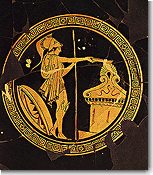






      |
|
|
|
The genos (family) in Archaic Athens was an institution based on kinship, and a member's status was hereditary. In most cases, of course, the families were linked both by the members' particular places of residence and by the shrines where the cults took place. Like the phratriai, the families were initially institutions with multiple competence: social, religious, and political. Political competence, which devolved mainly on the eupatrid families, gradually waned, so that after Cleisthenes the families were essentially outside any political system.
 | Certain families also had hereditary rights of priesthood, sacrifices and ritual relating to the Athenian body politic as a whole. The priests of Athena Polias, to take one example, were always from the Eteobutadae. Other such priestly families were the Praxiergidae, the Eumolpidae, and the Kerykes. There were similar priestly families in many parts of Hellas, often combining priesthood with divination, medicine, music, or the function of herald: the Tillidae in Elis, the Asclepiadae in Cos, the Homeridae at Chios, or the Talthybiadae at Sparta. It seems, however, that the oldest families at Athens were those who were connected with a specific site in the Attic countryside (e.g. Kolieis, Cephisieis, Salaminioi). |
|
| |
|
Note: Click on a picture for a brief description. | |